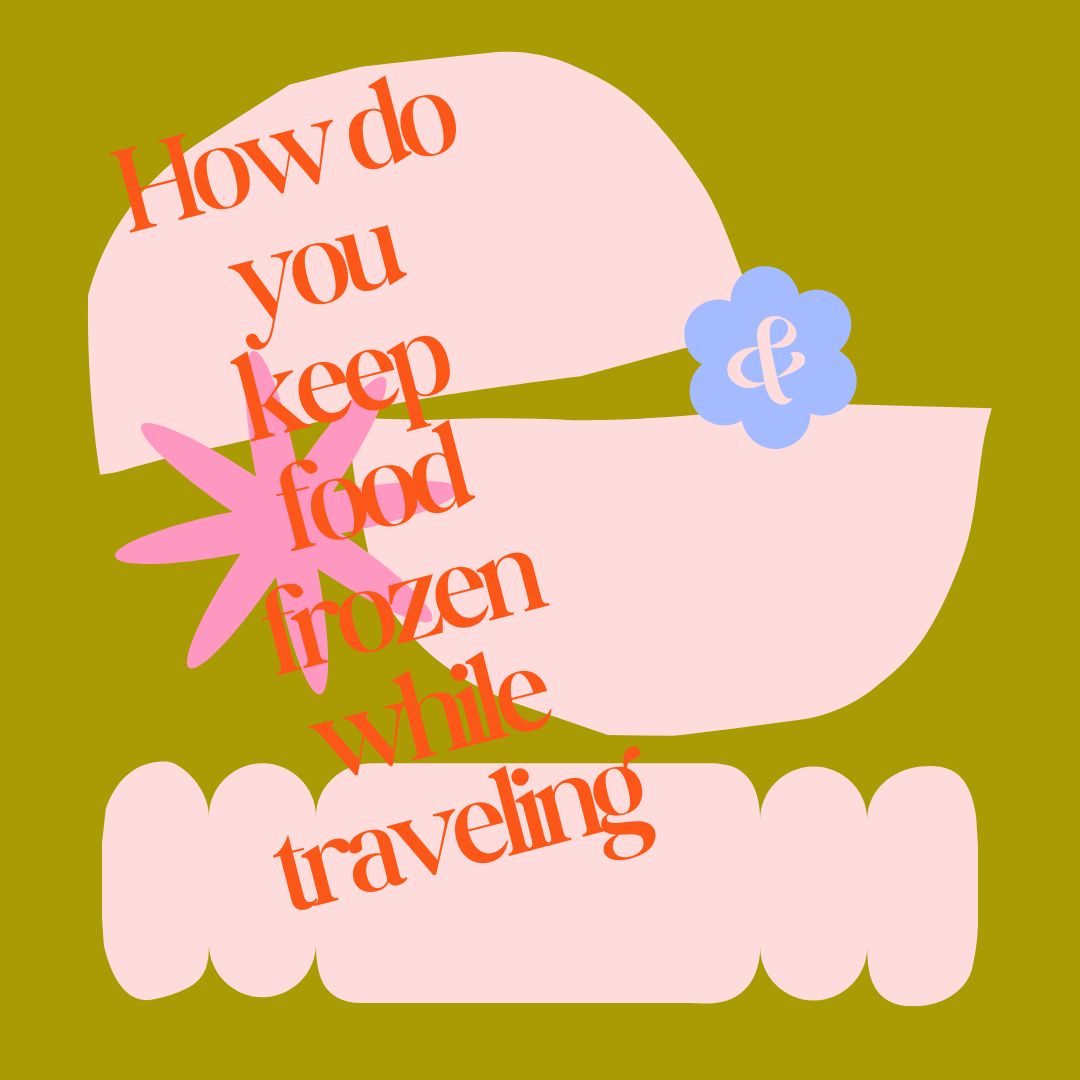How do you keep food frozen while traveling

Economic Considerations
Keeping food frozen while traveling can also have economic benefits. It allows you to:
- Buy in bulk and transport frozen goods
- Preserve leftovers or home-cooked meals for your trip
- Avoid food waste due to spoilage
Choosing the Right Cooler or Insulated Container
Types of Coolers
Hard-sided Coolers
Coolers with hard sides are durable and great at insulating. They are ideal for longer journeys when properly packed and can keep food frozen for several days.
Soft-sided Coolers
Because they are lighter and more portable, these are ideal for shorter journeys or additional storage.
Electric Coolers
Electric coolers can be plugged into a vehicle’s power outlet or a portable battery and provide constant cooling without the need for ice.
Factors to Consider When Selecting a Cooler
- Insulation quality
- Size and capacity
- Durability
- Portability
- Additional features (e.g., wheels, handles, drainage systems)
Top-rated Coolers for Keeping Food Frozen
Here’s a comparison table of some highly-rated coolers for keeping food frozen while traveling:
| Cooler Model | Type | Capacity | Ice Retention | Notable Features |
|---|---|---|---|---|
| YETI Tundra 65 | Hard-sided | 52 quarts | Up to 7 days | Bear-resistant, UV-resistant |
| RTIC 65 | Hard-sided | 65 quarts | Up to 10 days | Roto-molded construction, heavy-duty T-latches |
| Engel HD30 | Hard-sided | 30 quarts | Up to 10 days | Airtight seal, marine-grade latches |
| Arctic Zone Titan | Soft-sided | 30 cans | Up to 3 days | Deep Freeze insulation, leak-proof lining |
| Dometic CFX3 55IM | Electric | 53 quarts | N/A (powered) | WiFi app control, rapid freeze plate |
Packing Techniques for Optimal Freezing
Pre-freezing Your Food
Before packing, ensure all food items are thoroughly frozen. This step is crucial as it helps maintain the overall temperature inside the cooler.
Layering Method
- Start with a layer of ice or ice packs at the bottom
- Place frozen foods in the middle
- Top with another layer of ice or ice packs
Using Ice Packs and Frozen Water Bottles
Ice packs and frozen water bottles are great ways to keep temperatures low. They can also provide drinking water as they melt.
Vacuum Sealing
Foods that are vacuum-sealed require less space and are better protected from moisture, allowing them to remain frozen for longer.
Organizing for Easy Access
Pack items you’ll need first near the top to minimize the time the cooler is open.
Utilizing Different Types of Ice
Regular Ice
Pros:
- Inexpensive
- Easy to find
Cons:
- Melts quickly
- Can create a mess as it melts
Dry Ice
Pros:
- Keeps food frozen for longer periods
- Doesn’t create water as it sublimates
Cons:
- Requires careful handling
- May not be available everywhere
Gel Packs
Pros:
- Reusable
- No mess when thawing
Cons:
- May not stay as cold as regular ice
- Can be more expensive initially
Block Ice
Pros:
- Melts slower than crushed ice
- Provides long-lasting cooling
Cons:
- Heavy and bulky
- Can be difficult to fit around food items
The Dry Ice Method: A Deep Dive
Understanding Dry Ice
Dry ice is carbon dioxide that has frozen and sublimates (changes directly from solid to gas) at -109.3 degrees Fahrenheit (-78.5 degrees Celsius), making it very effective at keeping food frozen.
Safety Precautions When Handling Dry Ice
- Always wear insulated gloves
- Ensure proper ventilation when using dry ice
- Never store dry ice in an airtight container
- Keep dry ice away from skin and eyes
Calculating Dry Ice Needs
As a general rule, use 10-15 pounds of dry ice per 24-hour period for a medium-sized cooler. Factors affecting this include:
- Cooler size and insulation quality
- Ambient temperature
- Frequency of cooler opening
Packing with Dry Ice
- Line the bottom of the cooler with insulating material
- Place a layer of dry ice
- Add your frozen food items
- Top with another layer of dry ice
- Fill empty spaces with crumpled newspaper for insulation
Maintaining Temperature During Travel
Minimizing Cooler Opening
Each time you open the cooler, warm air enters and influences the inward temperature. To cut down on the number of times you need to open the cooler, plan ahead.
Storing the Cooler Properly
- Keep the cooler in the coolest part of your vehicle
- Avoid direct sunlight
- If possible, store in an air-conditioned space during stops
Using Multiple Coolers
Consider using separate coolers for:
- Frozen foods
- Refrigerated items
- Beverages and frequently accessed items
This strategy helps maintain the temperature of your frozen goods by reducing the frequency of opening the main freezer cooler.
Monitoring Temperature
To monitor the internal temperature, use a cooler thermometer. Take immediate action to lower it if it rises above 0°F (-18°C).
Special Considerations for Different Types of Travel
Road Trips
Planning Stops for Ice Replenishment
Research locations along your route where you can replenish ice or dry ice.
Utilizing Your Vehicle’s Climate Control
Keep the area where the cooler is stored cool by using your vehicle’s air conditioning.
Air Travel
TSA Regulations
Be aware of the TSA’s rules regarding frozen foods and ice packs. Frozen foods are typically permitted in carry-on and checked bags provided that they are solidly frozen when presented for screening.
Packaging for Air Travel
Use well-insulated, leak-proof containers that can withstand the rigors of air travel.
Camping and Outdoor Adventures
Using Natural Cooling Methods
Take advantage of natural cooling sources like streams or snow banks, but always use waterproof containers to protect your food.
Solar-powered Cooling Options
Consider investing in a solar-powered cooler for extended outdoor trips.
Food Selection and Preparation for Frozen Travel
Best Foods for Freezing
Some foods that freeze well include:
- Meats and poultry
- Fish and seafood
- Fruits and vegetables
- Soups and stews
- Baked goods
Pre-trip Food Preparation
- Cook and freeze meals in advance
- Portion foods into meal-sized containers
- Label all containers with contents and date
Foods to Avoid Freezing
Some foods don’t freeze well and should be avoided:
- Eggs in shells
- Canned foods
- Cream-based products
- Crisp fruits and vegetables
Thawing and Food Safety
Safe Thawing Methods
- Refrigerator thawing (slowest but safest)
- Cold water thawing (faster, requires more attention)
- Microwave thawing (quickest, but may partially cook food)
Recognizing Spoiled Food
Look for signs of spoilage such as:
- Off odors
- Changes in color or texture
- Presence of mold
Refreeze or Consume?
As a general rule, if the food still contains ice crystals or is 40°F or below, it’s safe to refreeze. However, quality may suffer.
Eco-friendly Options for Keeping Food Frozen
Reusable Ice Packs
Invest in high-quality, reusable ice packs to reduce waste from single-use ice.
Sustainable Cooler Options
Look for coolers made from recycled materials or those produced by companies with strong environmental commitments.
Minimizing Plastic Usage
Opt for reusable containers and avoid single-use plastic bags when packing your frozen foods.
Technology and Innovations in Food Freezing for Travel
Smart Coolers
These advanced coolers come with features like:
- Built-in thermometers
- Smartphone connectivity for temperature monitoring
- Solar-powered cooling systems
Vacuum Insulated Containers
For extended periods of time without ice, these containers use cutting-edge insulation technology to keep foods frozen.
Phase Change Materials
These materials ingest and deliver nuclear power during stage changes, giving steady temperature control.
FAQ Section about How do you keep food frozen while traveling
H4: How long can food stay frozen in a cooler?
The duration of time, the quantity and type of ice used, the cooler’s quality, and the outside temperature all play a role. A high-quality cooler can keep food frozen for up to two to five days with the right packing and dry ice.
H4: Can I use regular ice instead of dry ice?
Even though regular ice can be used, food can be frozen for longer with dry ice. Regular ice is ideal for shorter journeys when utilized in conjunction with other cooling methods.
H4: Is it safe to put dry ice in a regular cooler?
Albeit dry ice can be used in traditional coolers, satisfactory ventilation is expected to allow the gas to escape as the dry ice sublimates. Never store dry ice in an airtight container.
H4: How do I keep food frozen without electricity?
You can keep food frozen without power by utilizing a very much protected cooler loaded with dry ice or a mix of customary endlessly ice packs. It’s important to pack properly and keep the cooler from opening too much.
H4: What’s the best way to pack a cooler for maximum freezing efficiency?
For maximum efficiency, begin with a cooler that has already been chilled, layer it with ice or ice packs at the bottom and top, pack items tightly, fill empty spaces with additional ice or insulating materials, and minimize air pockets.
Conclusion of How do you keep food frozen while traveling
If the right information, tools, and methods are used, food can be frozen while traveling. By understanding the science of freezing, selecting the appropriate coolers, employing effective packing strategies, and making use of a variety of ice types, you can ensure that your frozen foods remain safe and of high quality throughout your journey. Change your strategies to meet the particular essentials of your trip, whether you are going by means of vehicle, in a plane, or on an endeavor in nature.
External Resources
- FDA’s guide on food safety while traveling: https://www.fda.gov/food/buy-store-serve-safe-food/handling-food-safely-while-traveling


1 thought on “How do you keep food frozen while traveling”